The most captivating part of Navaratri in Fort Kochi and Mattancherry is the women's celebration. They move boldly through the streets, helping one another in work and prosperity.
Published Sep 29, 2025 | 8:00 AM ⚊ Updated Oct 24, 2025 | 12:10 PM
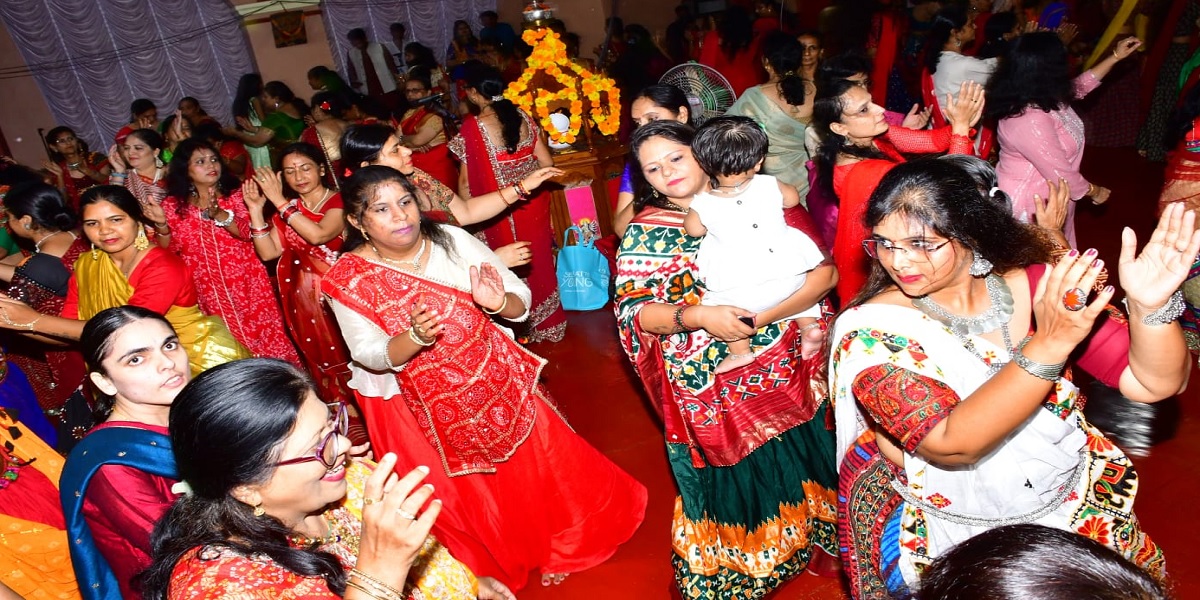
Women performing Garba during the Navratri celebrations at Shri Samudri Matha Mandir in Mattancherry.
Synopsis: The beats of drums merge into the darkness as the ‘garbha deep’ is lit, women in colourful costumes dance to the tunes in circles, reminiscent of the cyclic time in Hinduism, as the clash of dandiyas adds another uplifting layer to the aural experience. Come Navaratri, different communities in Fort Kochi and Mattancherry in Ernakulam deck up to celebrate the festival.
As the evening sun cast its golden glow over the Ram Temple in Mattancherry, 10-year-old Yamini knelt in prayer, her small hands folded with devotion.
It was around 5:30 pm, and her eyes sparkled with anticipation. Tonight, after 8 pm, she would join her community to perform the garbha (dandiya), swirling to the music and rhythm of drums in a celebration that would last until the early morning.
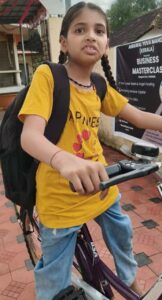
Yamini.
”I am planning to wear a red chaniya choli today—each day has a different colour theme—ten days, 10 colours, and you can also join us! The musicians are from Gujarat,” she chuckled with excitement before hurrying home to get ready for the celebrations.
Fort Kochi and Mattancherry, home to more than 30 distinct communities, including Jews, Jains, Arabs, Tamils, Konkanis, Goans, Gujaratis, and Anglo-Indians, thrived for centuries of harmonious multiculturalism. Here, Navaratri days burst with colours, music, and devotion, as lively as Deepavali itself.
The soul of Mattancherry’s Navaratri comes alive at the 120-year-old Shri Samudri Mata Mandir, a shrine dedicated to Goddess Durga. The temple, owned by the Bhatias, one of the 18 Gujarati denominations in Mattancherry, remains the cultural heart of the community.
All 18 groups come together under the umbrella of the Cochin Gujarati Mahajan.
This year, the mandir glows in vibrant shades of yellow, orange, and red, illuminated for the nine nights of devotion. The celebrations begin daily after 6 pm.
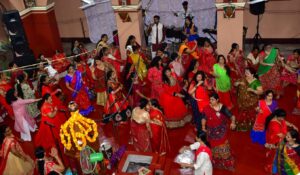
Dandiya.
Speaking to South First, Chetan D Shah, Secretary of the Shri Cochin Gujarati Mahajan, said, ”Dandiya is the main highlight of our Navaratri. It is where devotion meets dance. Rooted in the tale of Goddess Durga’s victory over Mahishasura, the decorated sticks, or dandiyas, represent her sword.”
What began with just five families in Ernakulam has grown into a spirited gathering of nearly 5,000 Gujaratis in West Kochi and over 170 families in Ernakulam. The celebration has also expanded beyond the community, with many non-Gujaratis now joining in, turning it into a carnival that spills into the city.
Yet, within the temple walls, traditions remain uncompromised. Only traditional garba and devotional music are performed, with artists specially invited from Gujarat. Bollywood tunes and filmi steps are strictly avoided.
Each evening also brings a spread of authentic Gujarati delicacies, with every day’s feast sponsored by a different family.
The Gujarati, Marathi, and other North Indian communities celebrate Navaratri more gaily, as most of them belong to the wealthy business class. They even have a Gujarati school in Mattancherry, and their celebrations stand apart.
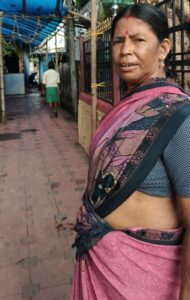
Rohini, a member of Mahajanawadi
But just a few meters away, the Kannada-speaking migrants of Mahajanawadi observe the festival in a simpler yet deeply traditional way.
Mahajanawadi is one of two Kannada settlements here, the other being Serwadi, together home to about 60 families. Though their roots trace back mainly to Kasaragod. Many migrated to Kochi during World War II in search of work.
Speaking to South First, Rohini from Mahajanawadi said, ”Navaratri at the Sri Mahadevi temple is when our community comes together. On the ninth day, the Darshanapaathri—or temple oracle—enters a trance believed to embody the Goddess. Devotees gather to watch as the oracle runs across fire and strikes themselves with a cane.”
She added, ”We may not be wealthy, but we celebrate Navaratri in its truest spirit.”
Lakshmi and Geetha hurry to finish their laundry at the Dhobi Khana, as they plan to visit the Subrahmaniya Temple on Dhobi Street in Veli, Fort Kochi, to decorate the bommai kolu and perform pujas. During the 10 days of Navaratri, they take special care to wear vibrant sarees.
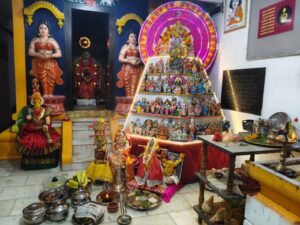
Bommai Kolu displayed at the temple
The Tamil-speaking Vannar community, traditionally washermen, lives about 150 meters north of the Dhobi Khana near Pallath Raman Hall. Believed to have migrated from Coimbatore and Tirunelveli centuries ago, the Vannars were reportedly invited by the King of Kochi to settle and provide laundry services, possibly during Portuguese or Dutch rule.
In 1975, with support from the Greater Cochin Development Authority, they established the Dhobi Khana at Veli near Fort Kochi.
Satheesh, president of the Vannar Sangham, explained to South First that Navaratri is primarily a women’s festival for their community. On the first day, the Ganapathi puja is performed, and wooden steps for the kolu are arranged with dolls and figurines, depicting gods and mythological characters.
Women are invited and given thamboolam, including bananas, sari, bangles, turmeric, sandalwood, and kumkum. The community also performs kummi kolattam, a dance similar to dandiya.

Women and children have gathered at the Subrahmaniya Temple to celebrate Navaratri.
On the day of Ashtami, books and tools are worshipped, followed by Sarasi puja, honoring nine unmarried girls and nine married women.
On the 10th day, Vijayadashami, Saraswati puja is conducted, gurus are respected, and children write their first letters while adults begin new courses or classes.
Apart from these communities, many more call this place home. Within just five kilometers, from Shipyard to Veli in Mattancherry, dozens of communities from around the world have lived together, respecting each other’s faiths. This harmony is at the soul of the city.
Yet, the most captivating part of Navaratri in Fort Kochi and Mattancherry is the women’s celebration. They move boldly through the streets, helping one another in work and prosperity. Every woman is seen as a reflection of Kali, Durga, Lakshmi, or Saraswati.
Let women celebrate, let them witness, let them rejoice, because their joy turns the streets into a festival of divinity.
(Edited by Majnu Babu).
